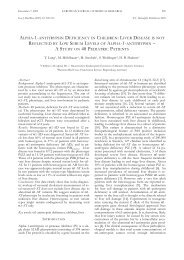European Journal of Medical Research - Deutsche AIDS ...
European Journal of Medical Research - Deutsche AIDS ...
European Journal of Medical Research - Deutsche AIDS ...
You also want an ePaper? Increase the reach of your titles
YUMPU automatically turns print PDFs into web optimized ePapers that Google loves.
June 27, 2007 EUROPEAN JOURNAL OF MEDICAL RESEARCH<br />
55<br />
B.8 (Poster)<br />
Cervical neck mass in HIV-infected patients<br />
Masuhr A. 1 , Drauz D. 1 , Kowol S. 1 , Arastéh K. 1<br />
1 Vivantes Auguste-Viktoria-Klinikum, Infektiologie und<br />
Gastroenterologie, Berlin, Germany<br />
Introduction: We report 58 (56 male, 2 female) HIV-infected<br />
patients who presented with an isolated cervical mass lesion<br />
at the Department <strong>of</strong> Infectious Diseases <strong>of</strong> the Vivantes Auguste-Viktoria-Klinikum,<br />
Berlin from 2001 through 2006.<br />
None <strong>of</strong> the patients was an IVDU, all <strong>of</strong> the males were<br />
MSM, and the two females had acquired HIV infection heterosexually.<br />
Methods: All patients were registered in the electronic medical<br />
database and data were retrospectively analysed for demographic,<br />
clinical, immunological and microbiological characteristics.<br />
Diagnosis was achieved by ultrasound guided<br />
biopsy in all patients. Biopsy material was evaluated after<br />
staining and immunohistology preparation.<br />
Results: The mean time between diagnosis <strong>of</strong> HIV infection<br />
and presentation for a cervical mass lesion was 6.5 years<br />
(range 1-20 yrs.). In 23 cases the histopathological findings<br />
showed a lymphoproliferative disease, 11 patients had<br />
Hodgkin’s disease, 10 had Non-Hodgkin’s lymphoma and<br />
two patients had lymph node metastasis <strong>of</strong> a solid carcinoma.<br />
Ten patients had acid-fast bacteria identified, 7 <strong>of</strong> them had<br />
mycobacterium tuberculosis and 3 had atypical mycobacteria<br />
on culture. Twenty-two patients were diagnosed with nonspecific<br />
lymphadenopathy, two patients had parotid cyst, and<br />
one had parotid pleomorphic adenoma. Patients with malignant,<br />
non-malignant, or infectious neck mass lesions showed<br />
no significant differences for age, duration <strong>of</strong> HIV infection<br />
and CDC staging.<br />
Conclusion: Biopsy revealed a diagnosis with an urgent need<br />
for treatment in almost two-third <strong>of</strong> the patients. Based on<br />
these findings, biopsy <strong>of</strong> HIV-infected patients with a neck<br />
mass lesion is strongly recommended regardless <strong>of</strong> constitutional<br />
signs and symptoms.<br />
B.9 (Vortrag)<br />
Retrospektive Analyse von Symptomatik und<br />
Therapieverlauf bei neun HIV-positiven Patienten<br />
mit multizentrischem Morbus Castleman<br />
Teutsch C. 1 , Träder C. 1 , Masuhr A. 1 , Arasteh K. 1 ,<br />
Kowol S. 1<br />
1 Auguste Viktoria Klinikum, Innere Medizin m. Sch.<br />
Infektiologie, Berlin, Germany<br />
Der multizentrische Morbus Castleman (MCD) ist eine seltene<br />
lymphoproliferative Erkrankung, die gehäuft bei HIVpositiven<br />
Menschen auftritt. Wir berichten in einer retrospektiven<br />
Analyse von neun HIV-positiven Patienten mit histologisch<br />
gesichertem MCD, die seit 1997 in unserer Klinik behandelt<br />
wurden. Das mediane Erkrankungsalter unserer Patienten<br />
betrug 41 Jahre. Alle Patienten waren männlich. Das<br />
mediane Überleben mit MCD war 33 Monate. Acht Patienten<br />
hatten bei Erstdiagnose eine generalisierte Lymphadenopathie,<br />
sieben eine Splenomegalie. Bei allen Patienten fand<br />
sich eine deutlich ausgeprägte B-Symptomatik und eine<br />
Anämie. Bei sieben Patienten konnte eine HHV-8-Assoziation<br />
nachgewiesen werden. Fünf Patienten hatten ein Kaposi-<br />
Sarkom. Im Krankheitsverlauf kam es bei einem Patienten zu<br />
einer Transformation zum Non-Hodgkin-Lymphom. Eine<br />
Splenektomie wurde bei drei Patienten durchgeführt. Therapeutisch<br />
wurde antiviral bei je fünf Patienten Foscarnet<br />
und/oder Cid<strong>of</strong>ovir eingesetzt. Sechs Patienten erhielten eine<br />
Polychemotherapie nach dem CHOP-Protokoll Ein Patient erhielt<br />
im Rezidiv nach CHOP IMVP-16. Ein Patient wurde mit<br />
Vinblastin behandelt. Rituximab wurde bei einem Patienten in<br />
Kombination mit CHOP eingesetzt. Bei sieben Patienten<br />
wurde mit der Diagnosestellung MCD mit einer ART begonnen.<br />
Unter der alleinigen virusstatischen Therapie mit<br />
Foscavir/Cid<strong>of</strong>ovir gab es bei aktivem MCD kein<br />
Ansprechen. Die sechs mit CHOP behandelten Patienten kamen<br />
in Remission, die bis zu 67 Monate anhielt (Median 17<br />
Monate). Ein weiterer Patient war nach Rituximab-CHOP 32<br />
Monate in Remission. Im Rezidiv nach CHOP war durch<br />
IMVP-16 bei einem Patienten eine erneute Remission für 14<br />
Monate erzielt worden. Ein Patient hatte nach Splenektomie<br />
und Immunrekonstitution unter ART eine Remission von 54<br />
Monate. Drei der vier verstorbenen Patienten starben im Rahmen<br />
des progredienten MCD, ein Patient an einem Analkarzinom/Kaposi-Sarkom.<br />
Zusammenfassend zeigte sich, daß beim<br />
HIV-assoziierten MCD CHOP eine wirksame und gut<br />
verträgliche Therapie ist. Im akuten Schub scheint eine<br />
alleinige antivirale Therapie mit Foscarnet oder Cid<strong>of</strong>ovir<br />
keinen ausreichenden Effekt beim MCD zu haben.<br />
B.10 (Poster)<br />
Gastrointestinal spindle cell tumor in a young<br />
HIV1-infected African woman<br />
Zoufaly A. 1 , Schmiedel S. 1 , Lohse A.W. 1 , van Lunzen J. 2<br />
1 Universitätsklinikum Hamburg-Eppendorf, 1. Medizinische<br />
Klinik, Hamburg, Germany, 2 Universitätsklinikum Hamburg-<br />
Eppendorf, Ambulanzzentrum Infektiologie, Hamburg,<br />
Germany<br />
Diffuse intestinal Kaposi sarcoma shares macroscopic and<br />
histopathologic features with gastrointestinal stromal tumors<br />
and correct diagnosis may pose a clinical challenge. We describe<br />
the case <strong>of</strong> a young HIV1 infected African lady without<br />
advanced immunodeficiency who presented with a diffuse<br />
spindle cell tumor <strong>of</strong> the gut. Initial diagnosis was that <strong>of</strong> a<br />
gastrointestinal stromal tumor based on endoscopy and<br />
histopathology. Further evaluation revealed evidence for human<br />
herpesvirus 8 and the diagnosis had to be changed to diffuse<br />
intestinal Kaposi sarcoma. Antiretroviral triple therapy<br />
together with chemotherapy was commenced and has led to a<br />
[Figure1]





